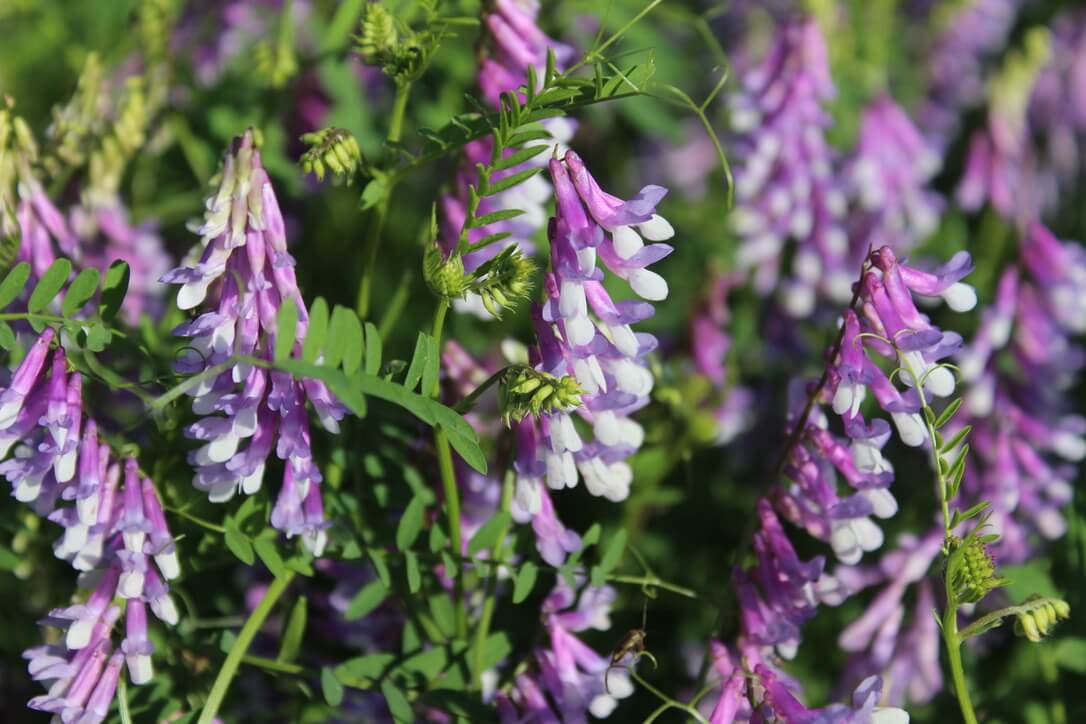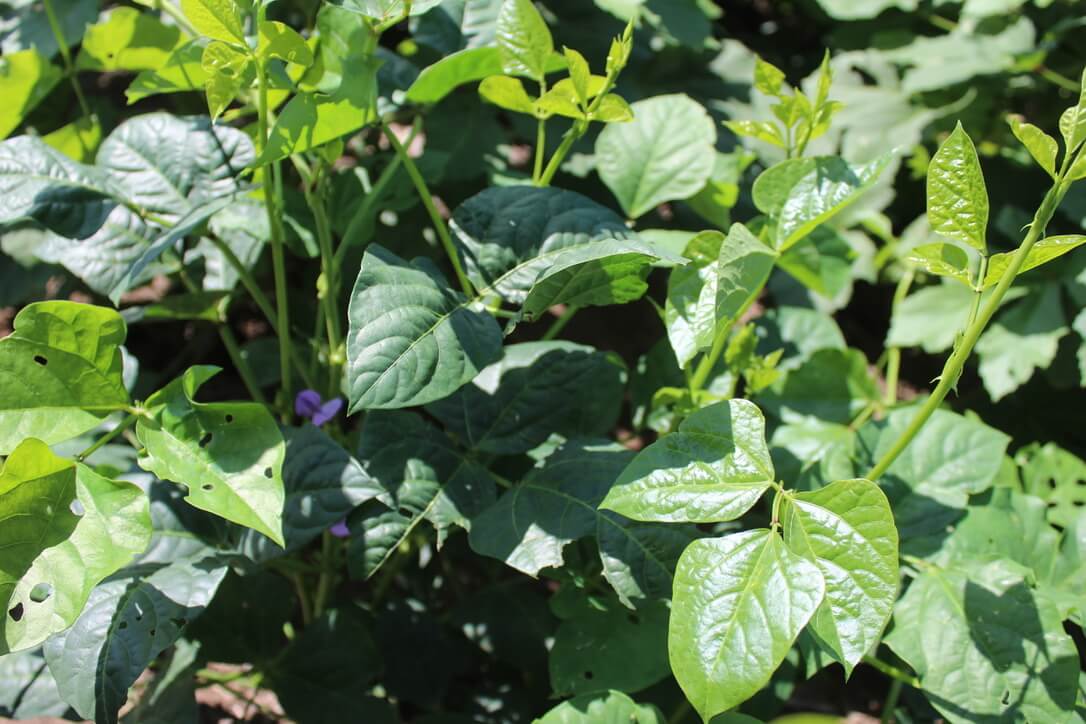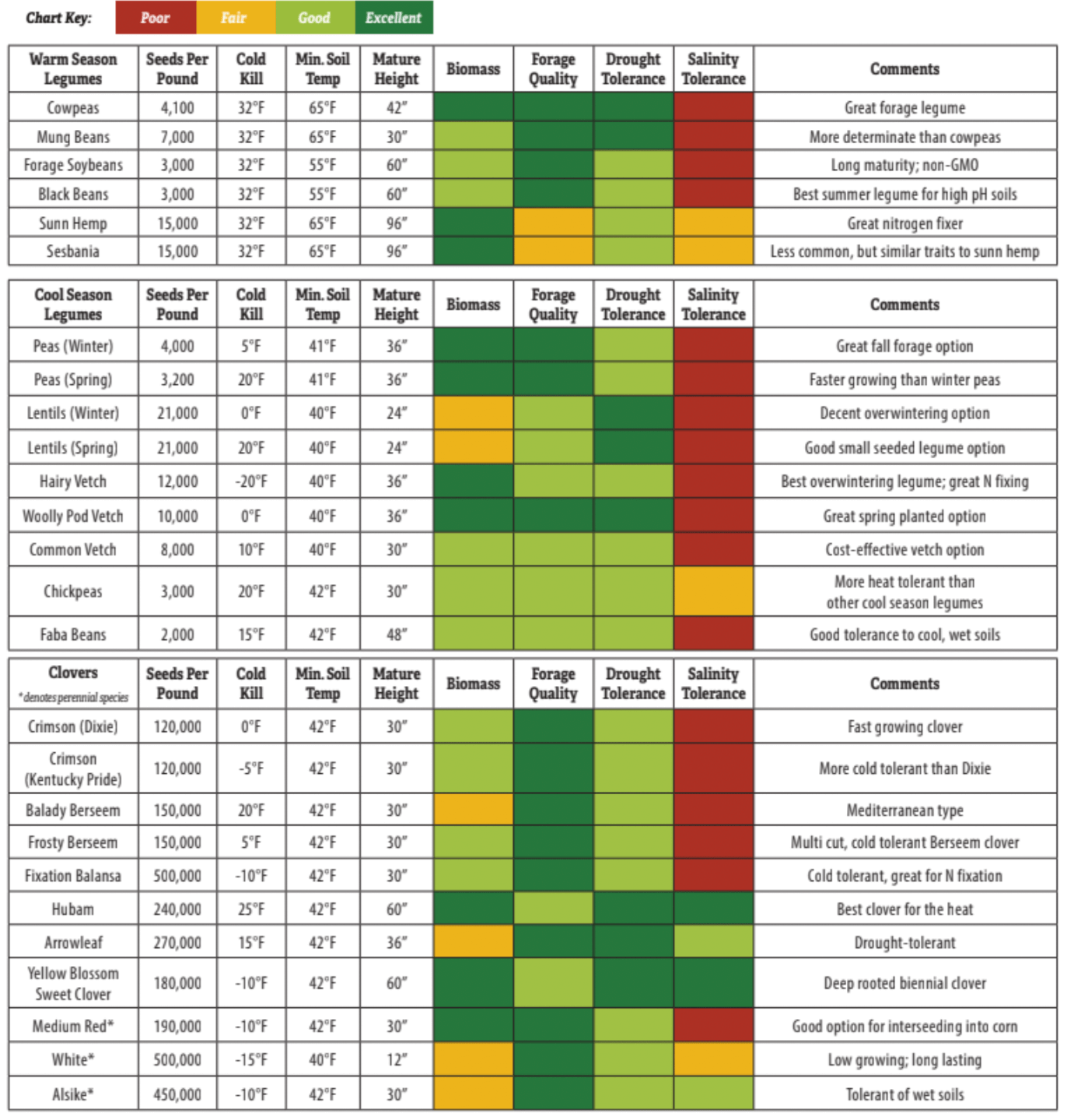Legumes are best known for their ability to form symbiotic relationships with rhizobia bacteria to fix atmospheric nitrogen . Many legumes are fast-growing and are excellent high protein forage species as well. They are also a valuable addition to mixes used to reduce erosion, build organic matter, and attract beneficial insects. Legume seeds are available inoculated with rhizobium bacteria to ensure complete, fast and successful nitrogen fixation. Here are our top 10 legume varieties by sales volume.

1. Hairy Vetch (Vicia villosa)
If cereal rye is the king of cover crops, then hairy vetch is the queen! No other legume is as consistently cold and winter hardy as hairy vetch. It is a great fit to combine with rye or triticale for fall plantings for spring weed control, erosion prevention and supplemental grazing. We often say that hairy vetch is “the easiest crop to grow and the most difficult one to harvest” because it is a very indeterminate plant, which means it continues to grow and bloom all the way through the reproduction phase of plant growth. When vetch is at full bloom, it terminates well with roller crimping and a thick mat of rolled vetch can give excellent weed control for the early part of the growing season.
2. Spring Peas (Pisium sativa)
Spring peas are an excellent addition to a spring mix, especially when planted with spring oats. They can produce good amounts of nitrogen for the following cash crop when allowed to go to flowering.Spring peas are highly mycorrhizal and are a great complement to soil biology, increasing access to water and nutrients for the rest of the mix or the next cash crop. Spring peas should be a part of all spring forage mixes because of their high protein content and palatability. Spring peas can also be fall interseeded into warm season perennial pastures to increase soil nitrogen, grazing and diversity during the perennial dormancy.
3. Cowpeas (Vigna unguiculata)
This heat and drought tolerant, warm-season legume is the most popular addition to summer mixes. The fast growth and wide leaves provide great protein, tonnage and forage value, especially when added to a sorghum-sudan mix. Cowpeas are a late-maturing legume, which allows for rotational grazing throughout the summer and a very small likelihood of making seed that will volunteer the next year.

4. Winter Peas (Pisium sativa)
Winter peas are good companions to fall mixes, especially when combined with hairy vetch. If planted in early fall, there can be good growth for fall grazing as a protein source in the mix and they will grow much later into the fall than spring peas. In order to maximize winter survival chances, winter peas need to be planted relatively late (about the middle of wheat planting season) and deep, up to 3 inches. These conditions will help protect the growing point of the pea and assists in survival in colder climates.

5. Sunn Hemp (Crotalaria juncea)
Sunn hemp is a heat-loving tropical plant that provides large amounts of nitrogen to summer cover crop mixes. Sunn hemp produces a great tap root to access deep moisture and nutrients and help break compaction layers. With its long tropical maturity, there is virtually no risk of it producing seed and volunteering. The fibrous structure of the stem helps it stand through winter as a snow catch crop. Although Sunn Hemp is not known for its grazing qualities, livestock, including deer, can browse on the leaves when they are young and tender.
6. Mung Beans (Vigna radiata)
Mung beans are the most drought-tolerant and heat-tolerant warm season legume. With their shorter maturity and determinant growth pattern, they can be planted later in the summer after a cereal grain and still provide lots of soil nitrogen. Mung bean pods do not split open at maturity, so when grazing late, livestock are able to graze the seed pods for protein in the late fall. Due to their smaller seed size, mung beans will have more seeds per pound compared to cowpeas, and can be an economical choice.
7. Crimson Clover (Trifolium incarnatum)
Crimson clover is a very versatile clover that can be planted in the spring, early summer or fall. With its high biomass growth, crimson clover can be a great weed suppressant, and produces large amounts of nitrogen, helping the subsequent cash crop get off to a good start. Crimson clover is also a good fit for corn interseed mixes, as it is semi-shade tolerant and is good for fall grazing after corn harvest. Crimson has a good chance of surviving winters in zone 6 and south.
8. Soybeans (Glycine max)
Soybeans can also be a good addition to a cover crop mix in systems where they are not part of the cash cropping rotation. They are excellent nitrogen fixers and can add high levels of protein to any hay or grazing mix. Deer are very attracted to soybean plants during the growing season and are commonly used in foodplot mixes.
9. Balansa Clover (Trifolium michelianum)
Fixation balansa clover is the most cold-tolerant annual clover; it can withstand temperatures down to -14˚F. Fixation can tolerate a variety of soil types and can even grow through short periods of standing water. As an annual clover, balansa also helps with soil drainage and water infiltration due to its deep tap root system.
10. Berseem Clover (Trifolium alexandrinum)
Berseem clover is a cool-season annual legume that is native to the Mediterranean region. For millennia, it has been the foundation for agriculture in the Nile Delta, featuring salt tolerance, high nitrogen fixation, and a synergistic relationship to alfalfa . Frosty Berseem, while preserving its Mediterranean genetics, has been bred for later maturity, cold tolerance, productivity, and nutritional value. There are two types of Berseem Clover, single-cut and multi-cut. Single-cut varieties, like Balady, are quick to grow, have good heat tolerance, and bloom earlier, giving a narrow window for harvest. Multi-cut varieties, like Frosty, are capable of delivering multiple cuttings.

This article first appeared in the 10th Edition of Green Cover's Soil Health Resource Guide.
Also check out the 11th edition, our latest Soil Health Resource Guide, over 90 pages packed with scientific articles and fascinating stories from soil health experts, researchers, farmers, innovators, and more! All as our complimentary gift to you, a fellow soil health enthusiast!